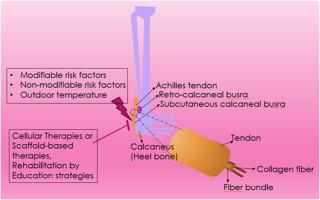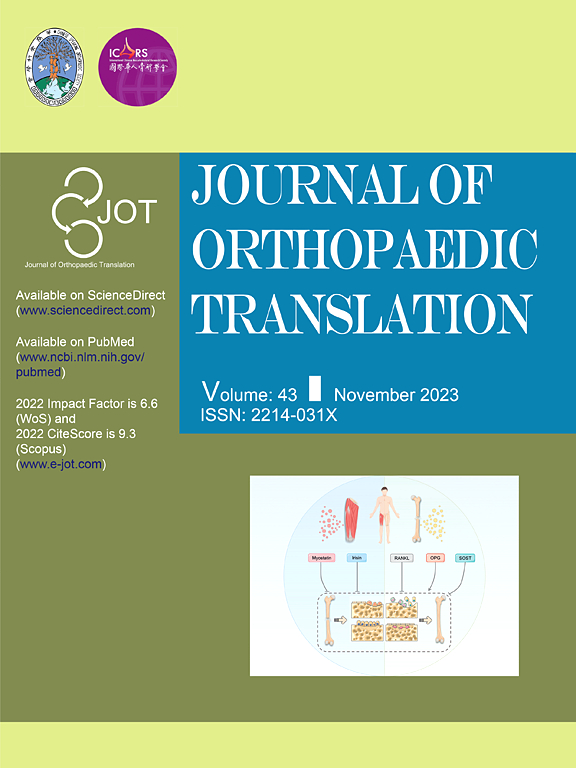跟腱风险分析断裂因素的最新进展,以加强损伤预防和临床指导:再生医学的当前影响
IF 5.9
1区 医学
Q1 ORTHOPEDICS
引用次数: 0
摘要
背景近年来,许多国家都在积极实施推广体育运动的计划和战略。尽管做出了这些努力,但伴随着体育锻炼的增加,肌肉和肌腱韧带损伤也显著增加,其中跟腱断裂最为常见,占此类损伤的 47%。本综述旨在总结决定跟腱断裂易感性的所有重要因素,以制定有效的个性化预防措施。方法本综述利用了多个数据库中的数据,包括 Elsevier、Global Health、PubMed-NCBI、Embase、Medline、Scopus、ResearchGate、RSCI、Cochrane Library、Google Scholar、eLibrary.ru 和 CyberLeninka。分析了跟腱损伤和断裂的不可改变和可改变的风险因素。结果分析发现了一些不可改变的风险因素,如遗传倾向、跟腱的解剖和功能特征、性别和年龄。在选择运动项目和设计训练计划时应考虑这些因素。可改变的风险因素包括营养失衡、运动方案不当以及对运动员跟腱状况的监测不足。及早治疗肌肉骨骼损伤、跟腱疾病、足部畸形和代谢紊乱至关重要。长期用药及其风险评估也是重要的考虑因素。此外,还介绍了治疗跟腱损伤的传统方法和手术方法的最新临床进展。比较了这些疗法在提高跟腱损伤患者功能疗效方面的功效。此外,还讨论了以细胞和支架为基础的疗法在促进细胞再生和修复跟腱损伤方面的进展。通过个性化的预防策略来解决这些因素,可以有效降低这些损伤的发生率。适当的营养、定期监测、及时治疗和纠正代谢紊乱是全面预防计划的重要组成部分。这些措施可以降低与体力活动和体育运动相关的跟腱断裂发病率,从而为保护公众健康做出重大贡献。本文的转化潜力本研究确定了跟腱损伤的主要可调节和不可调节风险因素,为个性化预防策略铺平了道路。强调营养、锻炼和肌肉骨骼问题的早期治疗,以及基于细胞的疗法的进步,为改善恢复和疗效提供了前景广阔的途径。这些发现可以指导预防和康复方面的临床实践,最终减少跟腱损伤,提高公众健康水平。本文章由计算机程序翻译,如有差异,请以英文原文为准。

Recent developments in Achilles tendon risk-analyzing rupture factors for enhanced injury prevention and clinical guidance: Current implications of regenerative medicine
Background
In recent years, many countries have actively implemented programs and strategies to promote physical education and sports. Despite these efforts, the increase in physical activity has been accompanied by a significant rise in muscle and tendon-ligament injuries, with Achilles tendon rupture being the most prevalent, accounting for 47 % of such injuries. This review aims to summarize all significant factors determining the predisposition of the Achilles tendon to rupture, to develop effective personalized prevention measures.
Objective
To identify and evaluate the risk factors contributing to Achilles tendon rupture and to develop strategies for personalized prevention.
Methods
This review utilized data from several databases, including Elsevier, Global Health, PubMed-NCBI, Embase, Medline, Scopus, ResearchGate, RSCI, Cochrane Library, Google Scholar, eLibrary.ru, and CyberLeninka. Both non-modifiable and modifiable risk factors for Achilles tendon injuries and ruptures were analyzed.
Results
The analysis identified several non-modifiable risk factors, such as genetic predisposition, anatomical and functional features of the Achilles tendon, sex, and age. These factors should be considered when selecting sports activities and designing training programs. Modifiable risk factors included imbalanced nutrition, improper exercise regimens, and inadequate monitoring of Achilles tendon conditions in athletes. Early treatment of musculoskeletal injuries, Achilles tendon diseases, foot deformities, and metabolic disorders is crucial. Long-term drug use and its risk assessment were also highlighted as important considerations. Furthermore, recent clinical advancements in both conventional and surgical methods to treat Achilles tendon injuries were described. The efficacy of these therapies in enhancing functional outcomes in individuals with Achilles injuries was compared. Advancements in cell-based and scaffold-based therapies aimed at enhancing cell regeneration and repairing Achilles injuries were also discussed.
Discussion
The combination of several established factors significantly increases the risk of Achilles tendon rupture. Addressing these factors through personalized prevention strategies can effectively reduce the incidence of these injuries. Proper nutrition, regular monitoring, timely treatment, and the correction of metabolic disorders are essential components of a comprehensive prevention plan.
Conclusion
Early identification of Achilles tendon risk factors allows for the timely development of effective personalized prevention strategies. These measures can contribute significantly to public health preservation by reducing the incidence of Achilles tendon ruptures associated with physical activity and sports. Continued research and clinical advancements in treatment methods will further enhance the ability to prevent and manage Achilles tendon injuries.
The translational potential of this article
This study identifies key modifiable and non-modifiable risk factors for Achilles tendon injuries, paving the way for personalized prevention strategies. Emphasizing nutrition, exercise, and early treatment of musculoskeletal issues, along with advancements in cell-based therapies, offers promising avenues for improving recovery and outcomes. These findings can guide clinical practices in prevention and rehabilitation, ultimately reducing Achilles injuries and enhancing public health.
求助全文
通过发布文献求助,成功后即可免费获取论文全文。
去求助
来源期刊

Journal of Orthopaedic Translation
Medicine-Orthopedics and Sports Medicine
CiteScore
11.80
自引率
13.60%
发文量
91
审稿时长
29 days
期刊介绍:
The Journal of Orthopaedic Translation (JOT) is the official peer-reviewed, open access journal of the Chinese Speaking Orthopaedic Society (CSOS) and the International Chinese Musculoskeletal Research Society (ICMRS). It is published quarterly, in January, April, July and October, by Elsevier.
 求助内容:
求助内容: 应助结果提醒方式:
应助结果提醒方式:


